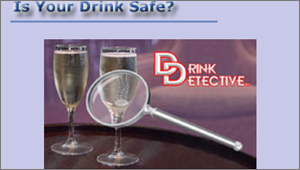Bar Chemistry that Could Save Your Life
by
 Forensic science is an integral part of life these days. Whether it’s a blood test at a crime scene or a paternity test on Maury, chemistry plays a critical role in solving many modern mysteries. Unfortunately, many of the techniques are applicable after the crime has taken place. However, for one class of terrifying drug-assisted assaults, simple chemistry is taking a preventative role.
Forensic science is an integral part of life these days. Whether it’s a blood test at a crime scene or a paternity test on Maury, chemistry plays a critical role in solving many modern mysteries. Unfortunately, many of the techniques are applicable after the crime has taken place. However, for one class of terrifying drug-assisted assaults, simple chemistry is taking a preventative role.
Scientists at Bloomsbury Innovations Limited (London, UK) developed the Drink Detective to instantly detect the presence of the three most common date-rape drugs: gamma-hydroxybutyrate, ketamine and benzodiazepines. With just five drops of a cocktail, the matchbook-sized kits can provide an immediate profile of your drink, alerting you of any potential contamination before trouble arises. The Drink Detective was awarded a Popular Science Magazine Innovation Award in 2004.
Since these drugs only remain in the body for a few hours, victims typically realize they’ve been assaulted long after the compounds have been metabolized and excreted. Given the lack of evidence, these crimes are often very difficult to prove. Below is a breakdown of the three classes of compounds to be aware of and how the Drink Detective identifies them.
Gamma-hydroxybutyrate (GHB)
Referred to as the date-rape drug, GHB is a sedative-hyponotic originally developed as a sleep-aid. It causes memory problems, mental/physical paralysis and renders the victim incapable of resisting. Unfortunately, the effects are intensified when used in combination with alcohol.
Test: Because illicit GHB production requires NaOH, it is highly alkaline and will therefore cause tainted drinks to also become basic. Since most drinks are acidic, a drink with a basic pH is highly suspicious. Noted exceptions include milk-containing drinks, which have a near neutral pH.
Ketamine
Ketamine is an anesthetic and analgesic used in surgery to dissociate perception from sensation. Physical effects of the drug range from a dreamy, floating feeling (at low doses) to a hallucinogenic, out-of-body feeling (at higher doses).
Test: Reaction with ketamine, a secondary amine, results in a red/orange derivative. Since the test is selective for amines, it will also detect the presence of other potential contaminants such as ecstacy, speed and cocaine.
Benzodiazepines (Benzos)
This class is among the most widely prescribed drugs, as they are used in treatment of insomnia and anxiety. Two of the most recognizable benzos are Valium and Rohypnol, with the latter being more potent. Rohypnol administration results in the rapid onset of symptoms, including muscle relaxation, sleepiness, and mental/physical paralysis. Worse, when ingested in combination with alcohol, benzos cause anterograde amnesia, where events taking place during the time the drug was in effect are forgotten.
Test: Described as a competitive immunoassay, this test detects all benzodiazepine family members, which includes over 40 drugs.
Although we have not tried this product, the use of chemistry to help prevent such a dangerous crime is to be applauded. Watching the bartender make a drink and hand it to you is a good first step, but it’s difficult to keep focused on it every second. We spend all day in lab looking over chemistry. It’s good to know that when we need it, chemistry can return the favor.


dayman
wrote on October 15, 2009 at 7:57 pm
While this may work, I personally prefer carrying around a mouse in my pocket. I have it take a sip of my drink every so often and then check if it gets sleepy.
It has served me well so far, though I have claw marks all over my legs for some odd reason…
PlayLady
wrote on October 21, 2009 at 12:10 pm
This will come in handy if I decide to relive the "glory days" of my 20's.